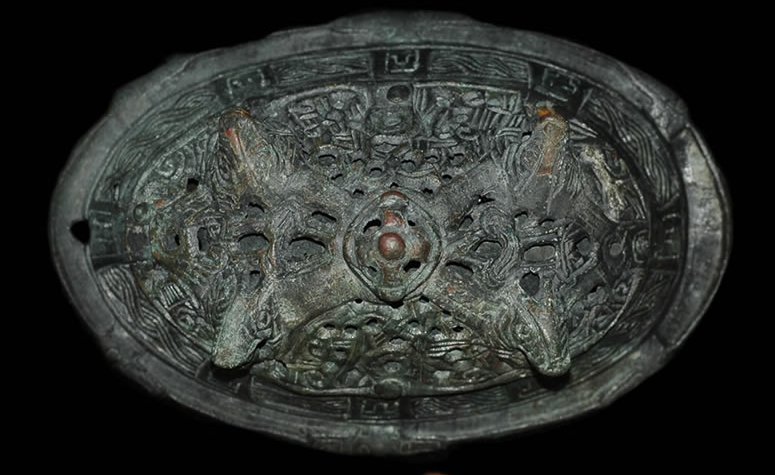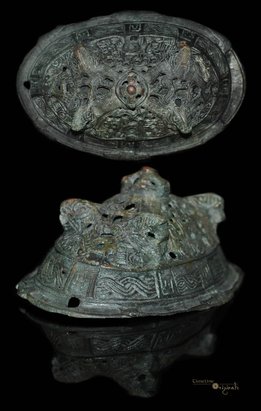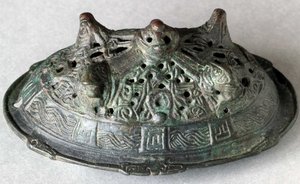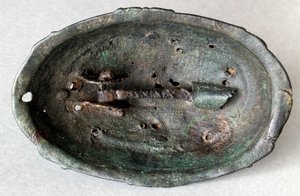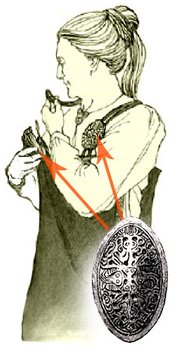Viking tortoise brooch
A viking 'Five-Lobed' Openwork Tortoise Brooch
Copper-alloy, 100.8 grams, 110.48 mm. 9th-11th century. A domed, hollow, elliptical brooch usually worn in pairs by Scandinavian women from England to Ukraine. The uppermost feature is an openwork dome with a hemispherical top-mount and a double-contour collar. From this radiate four double-contour bands which lead to the upper and lower lobes, each in the form of an animal-head with billetted neck in Jellinge Style. Between these are panels of double-contour tendril interlace executed in openwork. The outer edges of this field are pierced for rivets, of which four remain in situ. Outside the openwork panels is a solid zone consisting of two-strand guilloches interspersed with rectangular panels bearing interlocking 'T'- and 'U'-shaped motifs. Outside this is the flange of the brooch which is plain apart from the outer rim which bears animal-head decoration. The catchplate and hinge-lug are present, with remains of the substantial iron pin still in place.
Published in:
British artefacts Volume 2 - Middle Saxon and Viking by Brett Hammond (2010) page 40/41, fig. 1.1.3-c.
Although in ever viking department of a national museum, the quality of mine example is one of museum quality (wich I'm very proud of).
The most beautiful (even with the golden gilding still on top of them !) I have seen at the National Museum in Oslo. A "must do",
if you like these oval brooches to see in their most origin well preserved form !
Conservating artefacts
After some years I discovered the tortoise brooch became somewhat bleak at one side of the upper. I did not trust it and brought it to a reputable archeologist who cleaned it (among several other items). LUCKILY the brooch was saved by that treatment and had a surprise too..
Although hollow, the needle, wich priorly was covered with a thick plague of rust, was 'excavated' and was intact on the outside ! The needle, hollow inside as said, was filled with plastic and could remain intact this way. The overall colour of the brooch changed somewhat through cleaning, but what to consider that as a problem, as your gems are literally saved from detoriation ..
Now this is an serious advice to any collector:
Be sure of the state your artefact(s) are in. Both at time when you have them first in hand, as later in time. Ask yourself ALWAYS these questions:
- did the salesman (or someone who had the item before him !) something with the item to make it (look) clean ? I do not go into detail to the horror stories people can do with artefacts.
But..
- can I recognise the diseases wich can pop up, like bronze disease ?
In case of ANY DOUBT - show it to a reputable man who can treat the item professionally. Professionally in CAPITAL LETTERS, serious, people.
It had saved several items in my collection this way.
Drawing above:
How where viking oval brooches worn?
Also see link:
A tortoise shell brooch from Karelia
and
How were viking oval brooches made?
Well. I could have been with these stones until after dark, but as my wife wanted to travel on.. well.. I see you again, some day, hogback stones from Gosforth. And if you happen to be there one day, do not forget that monument on the outside...
Further on with the Cumbrian hogbacktour !
In - yes, luckily again in - St. Peter's church in Heysham, there is a truly beautiful hogback stone. The guide told us, it had been studyied by Thor Ewing, a writer, in 2000. in 'Understanding the Heysham hogback' A tenth century sculpted stone monument and its context (link), Thor Ewing tells in detail what he dicovered on the both sides of this hogback stone.
Just being brought in the church as late as the 1970's accompanied with some protest here and there among the church visitors, considered as being a token of old paganism, it had been remarkably nice preserved, and a lot of detail can be seen, still. Truly worthwile a visit.
I had a small debate with the guide in the church if the - zoomorphic, in my opinion - faces on the sides were lions (or hippo's). The guide doubted if the vikings could have known about lions. Well I guess so, concerning the runes on the Ancient Greek lion statue at the Arsenal, Venice. For example. Vikings did travel south..
But when he told me he was doubting the vikings 'discovered' (as the native inhabitants were of course, in the first place) America before Columbus, I decided to rest my case..
One has to know when to start and to end a conversation ..
Just discovered the book in a bookstore written by Geoff Holder - The guide to the mysterious Lake District, I knew there had to be another hogback stone in Lowther, St. Micheal's Church. With a promising image described in the text of 'a naval and a land-based force of shield-bearing vikings above a fish and what might be a coiled sea serpent. On the reverse is a row of female figures with snakes, possibly a representation of the hideous hag Hel'. Wow. If that did not sound as a true pagan promised land ..
Not complaing too much after all we have seen, this visit was the dissapointing one of them all. But if you wife states 'I am happy to have seen them' and I am answering 'Measuring is knowing' and the even more obligate verb 'handling 'if we did not see it at all, we wouldn't have known anything at all of how they were looking' the glass was again half full, at the last day of our journey..
The hogback stone appeared to be just being tolerated within the entrance segment part of the church. As something you never use anymore but you do not throw away - entirely. That sort of feeling emerged when seeing this hogback asylum seekers.. Bed, bath and bread, ás we say in Dutch, but no luxury at all and standing on some outcuts of wood, you would balance the table with at home..
Come on, St. Micheal's Church.. care a bit more of your 'children' !
This hogback stone was moved in the church in 1907. Hogback stones layed partially buried in the churchyard before it was dug up and moved into the church.
The promising depiction of a longship - as certainly can be seen after some studying - see http://vikingminds.co.uk/pages/longship
we have missed !
The stone itself is (157 x 50 x 30 cm) and very worn.
The hogback stones in Cumbria - very diverse in quality, but everyone worth a visit ! Especially on a gloomy day in late October ...
The churches to visit - see photos of resp. St. Andrew's church in Penrith, St. Mary's church in Gosforth, St. Peter's church in Heysham and St. Micheal's church in Lowther.
Did I miss out on another one in Cumbria ? Let me know !
In a next blog I will take you to four - still remaining utterly mysterious- statues 'guarding' the graveyard of St. Andrew's church in Dacre..
For the last blog of October 9th see this link.
References: (as always, links to where the books can be ordered are attached).
Edwards, B.J.N. Vikings in North West England - The artifacts (1998);
Emery, Gordon, CURIOUS CUMBRIA, The Lake District & Beyond: A celebration of Cumbria (2023)
Ewing, T. 'Understanding the Heysham hogback' A tenth century sculpted stone monument and its context ;
Hall, R. Viking Age archaeology in Britain and Ireland (first printed 1990, reprinted with amendments in 1995);
Holder, G. The guide to the mysterious Lake District (2009)
possibly also (as there within the part of Cumbria dealing with Carlisle, the Eden Valley, Barrow-in-Furness, Whitehaven and the west coast is being dealed with)
Holder, G. Paranormal Cumbria (2010)
http://vikingminds.co.uk/pages/longship
